Singapore's Economic Strategies
VerifiedAdded on 2020/02/24
|16
|2894
|97
AI Summary
This assignment delves into Singapore's economic landscape, analyzing key factors influencing its growth. It examines the impact of imported inflation and the government's measures to mitigate price increases through exchange rate management. The assignment also explores the relationship between energy consumption and economic growth, referencing ASEAN-5 countries for comparative analysis. Furthermore, it investigates the labor force participation rate in Singapore and its implications for sustainable development.
Contribute Materials
Your contribution can guide someone’s learning journey. Share your
documents today.

ECONOMICS
Economics
Name of the Student
Name of the University
Author note
Economics
Name of the Student
Name of the University
Author note
Secure Best Marks with AI Grader
Need help grading? Try our AI Grader for instant feedback on your assignments.
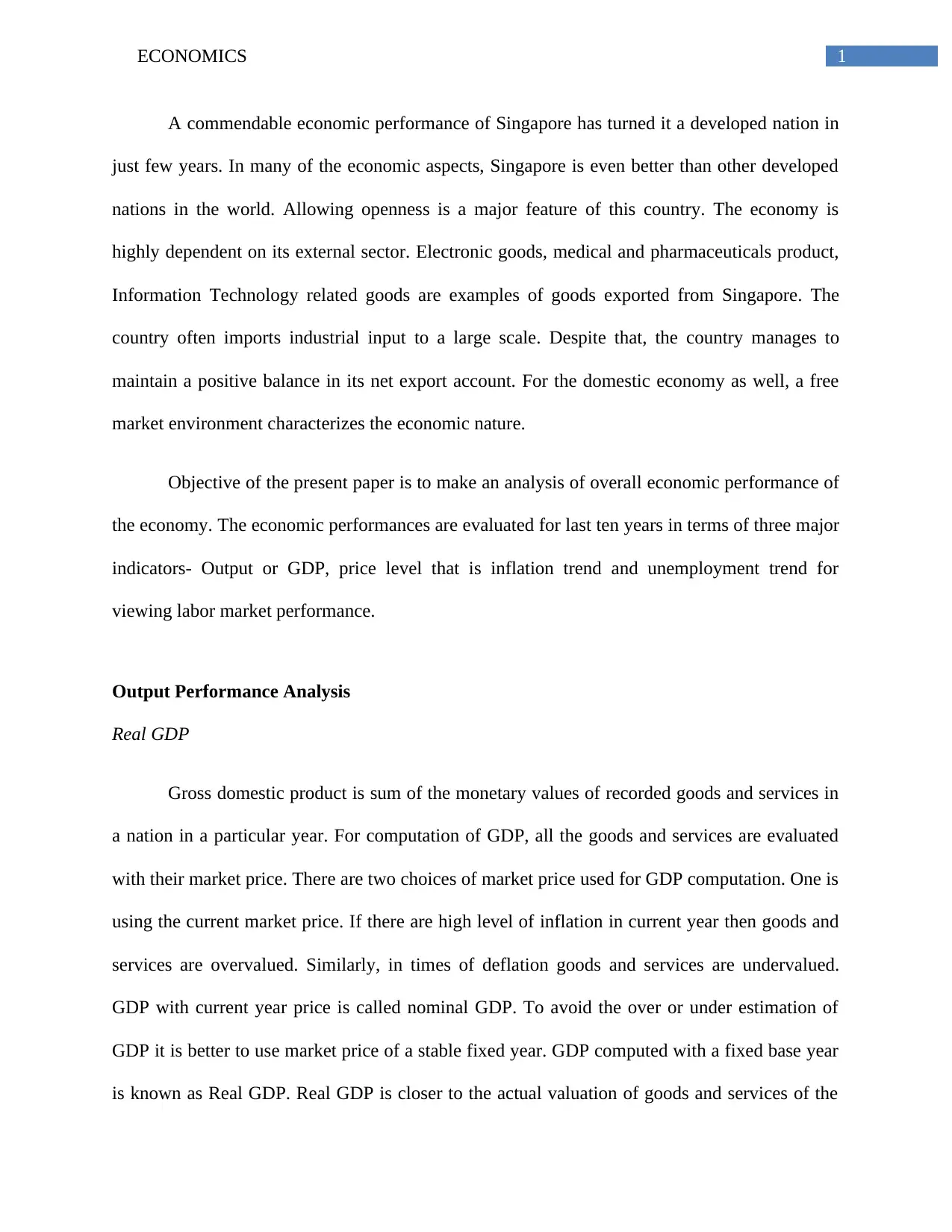
1ECONOMICS
A commendable economic performance of Singapore has turned it a developed nation in
just few years. In many of the economic aspects, Singapore is even better than other developed
nations in the world. Allowing openness is a major feature of this country. The economy is
highly dependent on its external sector. Electronic goods, medical and pharmaceuticals product,
Information Technology related goods are examples of goods exported from Singapore. The
country often imports industrial input to a large scale. Despite that, the country manages to
maintain a positive balance in its net export account. For the domestic economy as well, a free
market environment characterizes the economic nature.
Objective of the present paper is to make an analysis of overall economic performance of
the economy. The economic performances are evaluated for last ten years in terms of three major
indicators- Output or GDP, price level that is inflation trend and unemployment trend for
viewing labor market performance.
Output Performance Analysis
Real GDP
Gross domestic product is sum of the monetary values of recorded goods and services in
a nation in a particular year. For computation of GDP, all the goods and services are evaluated
with their market price. There are two choices of market price used for GDP computation. One is
using the current market price. If there are high level of inflation in current year then goods and
services are overvalued. Similarly, in times of deflation goods and services are undervalued.
GDP with current year price is called nominal GDP. To avoid the over or under estimation of
GDP it is better to use market price of a stable fixed year. GDP computed with a fixed base year
is known as Real GDP. Real GDP is closer to the actual valuation of goods and services of the
A commendable economic performance of Singapore has turned it a developed nation in
just few years. In many of the economic aspects, Singapore is even better than other developed
nations in the world. Allowing openness is a major feature of this country. The economy is
highly dependent on its external sector. Electronic goods, medical and pharmaceuticals product,
Information Technology related goods are examples of goods exported from Singapore. The
country often imports industrial input to a large scale. Despite that, the country manages to
maintain a positive balance in its net export account. For the domestic economy as well, a free
market environment characterizes the economic nature.
Objective of the present paper is to make an analysis of overall economic performance of
the economy. The economic performances are evaluated for last ten years in terms of three major
indicators- Output or GDP, price level that is inflation trend and unemployment trend for
viewing labor market performance.
Output Performance Analysis
Real GDP
Gross domestic product is sum of the monetary values of recorded goods and services in
a nation in a particular year. For computation of GDP, all the goods and services are evaluated
with their market price. There are two choices of market price used for GDP computation. One is
using the current market price. If there are high level of inflation in current year then goods and
services are overvalued. Similarly, in times of deflation goods and services are undervalued.
GDP with current year price is called nominal GDP. To avoid the over or under estimation of
GDP it is better to use market price of a stable fixed year. GDP computed with a fixed base year
is known as Real GDP. Real GDP is closer to the actual valuation of goods and services of the
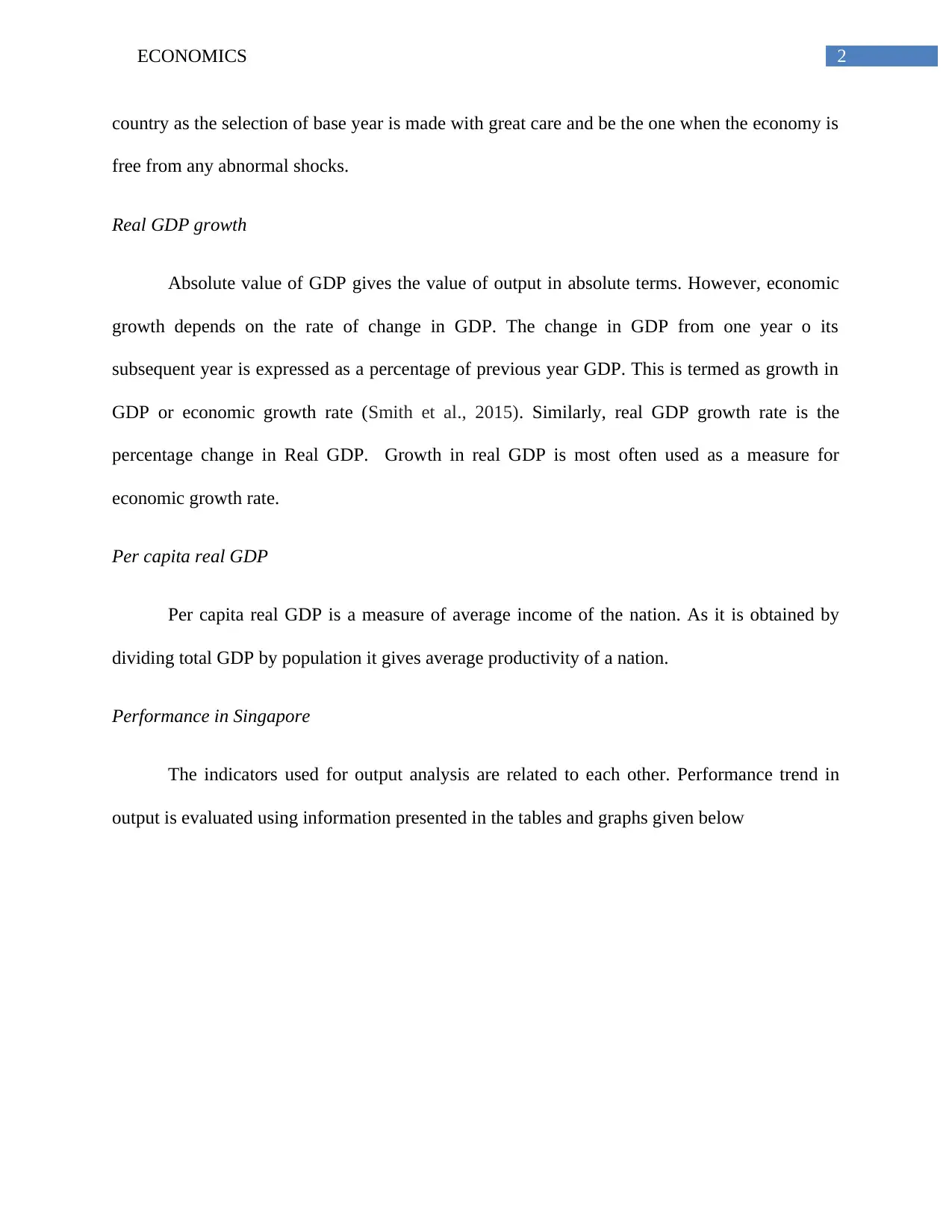
2ECONOMICS
country as the selection of base year is made with great care and be the one when the economy is
free from any abnormal shocks.
Real GDP growth
Absolute value of GDP gives the value of output in absolute terms. However, economic
growth depends on the rate of change in GDP. The change in GDP from one year o its
subsequent year is expressed as a percentage of previous year GDP. This is termed as growth in
GDP or economic growth rate (Smith et al., 2015). Similarly, real GDP growth rate is the
percentage change in Real GDP. Growth in real GDP is most often used as a measure for
economic growth rate.
Per capita real GDP
Per capita real GDP is a measure of average income of the nation. As it is obtained by
dividing total GDP by population it gives average productivity of a nation.
Performance in Singapore
The indicators used for output analysis are related to each other. Performance trend in
output is evaluated using information presented in the tables and graphs given below
country as the selection of base year is made with great care and be the one when the economy is
free from any abnormal shocks.
Real GDP growth
Absolute value of GDP gives the value of output in absolute terms. However, economic
growth depends on the rate of change in GDP. The change in GDP from one year o its
subsequent year is expressed as a percentage of previous year GDP. This is termed as growth in
GDP or economic growth rate (Smith et al., 2015). Similarly, real GDP growth rate is the
percentage change in Real GDP. Growth in real GDP is most often used as a measure for
economic growth rate.
Per capita real GDP
Per capita real GDP is a measure of average income of the nation. As it is obtained by
dividing total GDP by population it gives average productivity of a nation.
Performance in Singapore
The indicators used for output analysis are related to each other. Performance trend in
output is evaluated using information presented in the tables and graphs given below
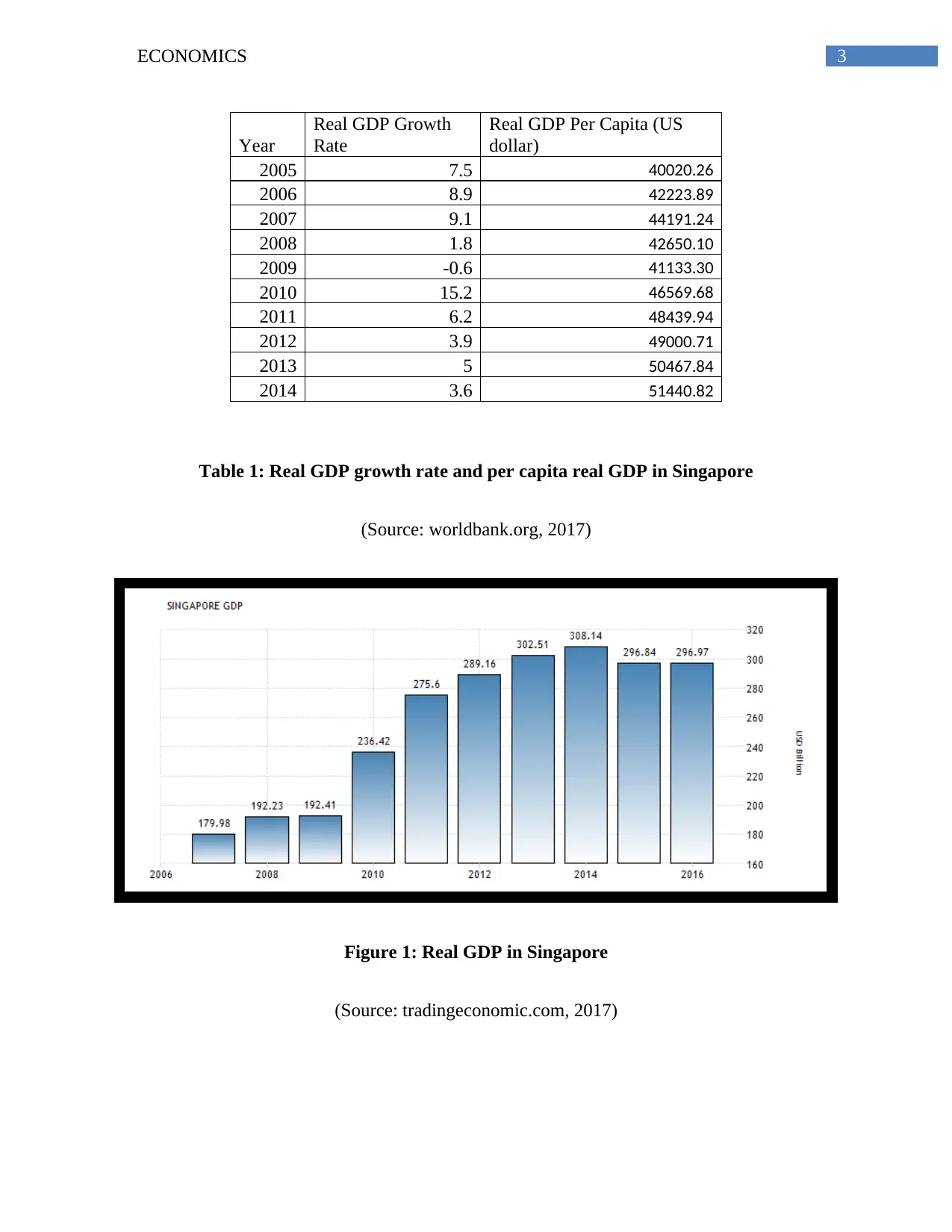
3ECONOMICS
Year
Real GDP Growth
Rate
Real GDP Per Capita (US
dollar)
2005 7.5 40020.26
2006 8.9 42223.89
2007 9.1 44191.24
2008 1.8 42650.10
2009 -0.6 41133.30
2010 15.2 46569.68
2011 6.2 48439.94
2012 3.9 49000.71
2013 5 50467.84
2014 3.6 51440.82
Table 1: Real GDP growth rate and per capita real GDP in Singapore
(Source: worldbank.org, 2017)
Figure 1: Real GDP in Singapore
(Source: tradingeconomic.com, 2017)
Year
Real GDP Growth
Rate
Real GDP Per Capita (US
dollar)
2005 7.5 40020.26
2006 8.9 42223.89
2007 9.1 44191.24
2008 1.8 42650.10
2009 -0.6 41133.30
2010 15.2 46569.68
2011 6.2 48439.94
2012 3.9 49000.71
2013 5 50467.84
2014 3.6 51440.82
Table 1: Real GDP growth rate and per capita real GDP in Singapore
(Source: worldbank.org, 2017)
Figure 1: Real GDP in Singapore
(Source: tradingeconomic.com, 2017)
Secure Best Marks with AI Grader
Need help grading? Try our AI Grader for instant feedback on your assignments.
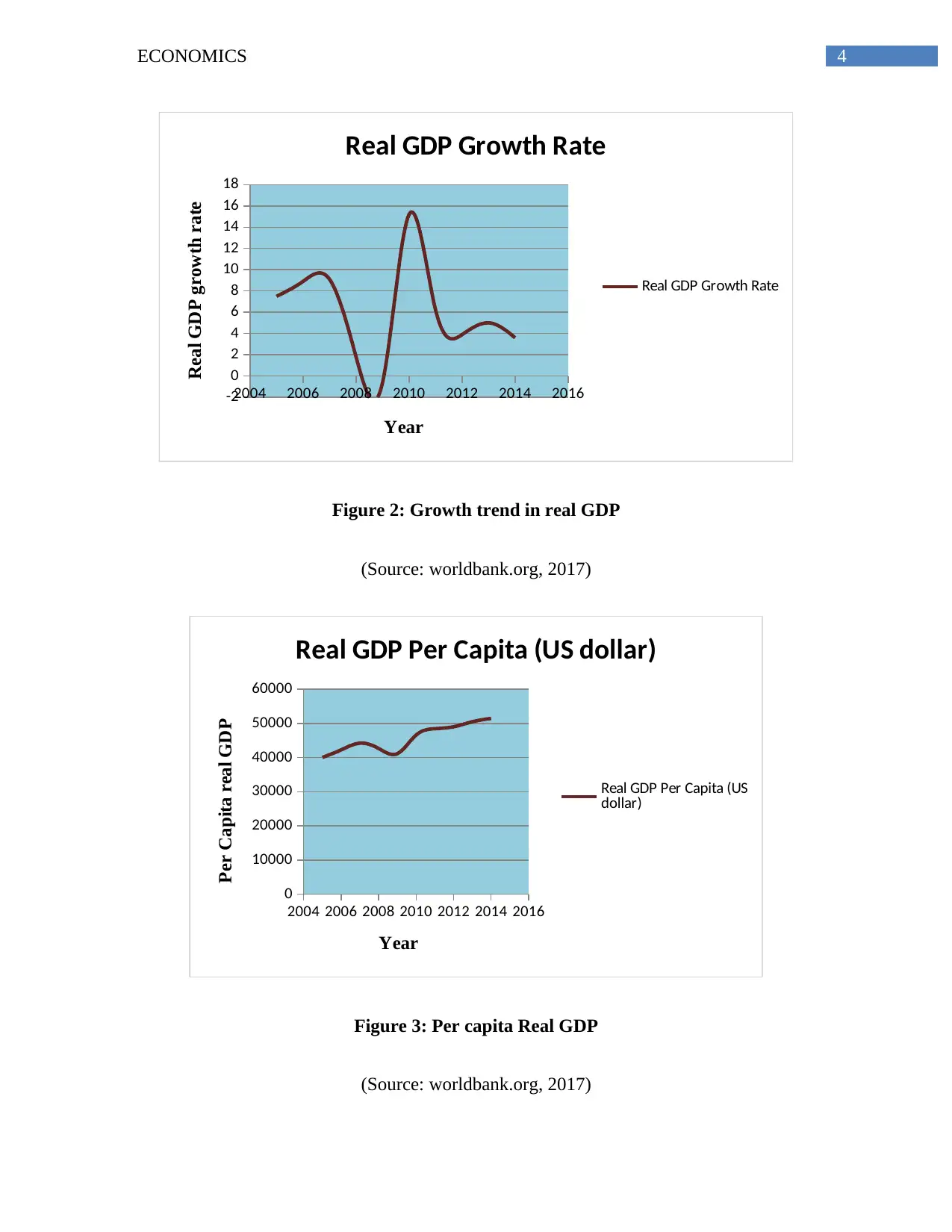
4ECONOMICS
2004 2006 2008 2010 2012 2014 2016-2
0
2
4
6
8
10
12
14
16
18
Real GDP Growth Rate
Real GDP Growth Rate
Year
Real GDP growth rate
Figure 2: Growth trend in real GDP
(Source: worldbank.org, 2017)
2004 2006 2008 2010 2012 2014 2016
0
10000
20000
30000
40000
50000
60000
Real GDP Per Capita (US dollar)
Real GDP Per Capita (US
dollar)
Year
Per Capita real GDP
Figure 3: Per capita Real GDP
(Source: worldbank.org, 2017)
2004 2006 2008 2010 2012 2014 2016-2
0
2
4
6
8
10
12
14
16
18
Real GDP Growth Rate
Real GDP Growth Rate
Year
Real GDP growth rate
Figure 2: Growth trend in real GDP
(Source: worldbank.org, 2017)
2004 2006 2008 2010 2012 2014 2016
0
10000
20000
30000
40000
50000
60000
Real GDP Per Capita (US dollar)
Real GDP Per Capita (US
dollar)
Year
Per Capita real GDP
Figure 3: Per capita Real GDP
(Source: worldbank.org, 2017)
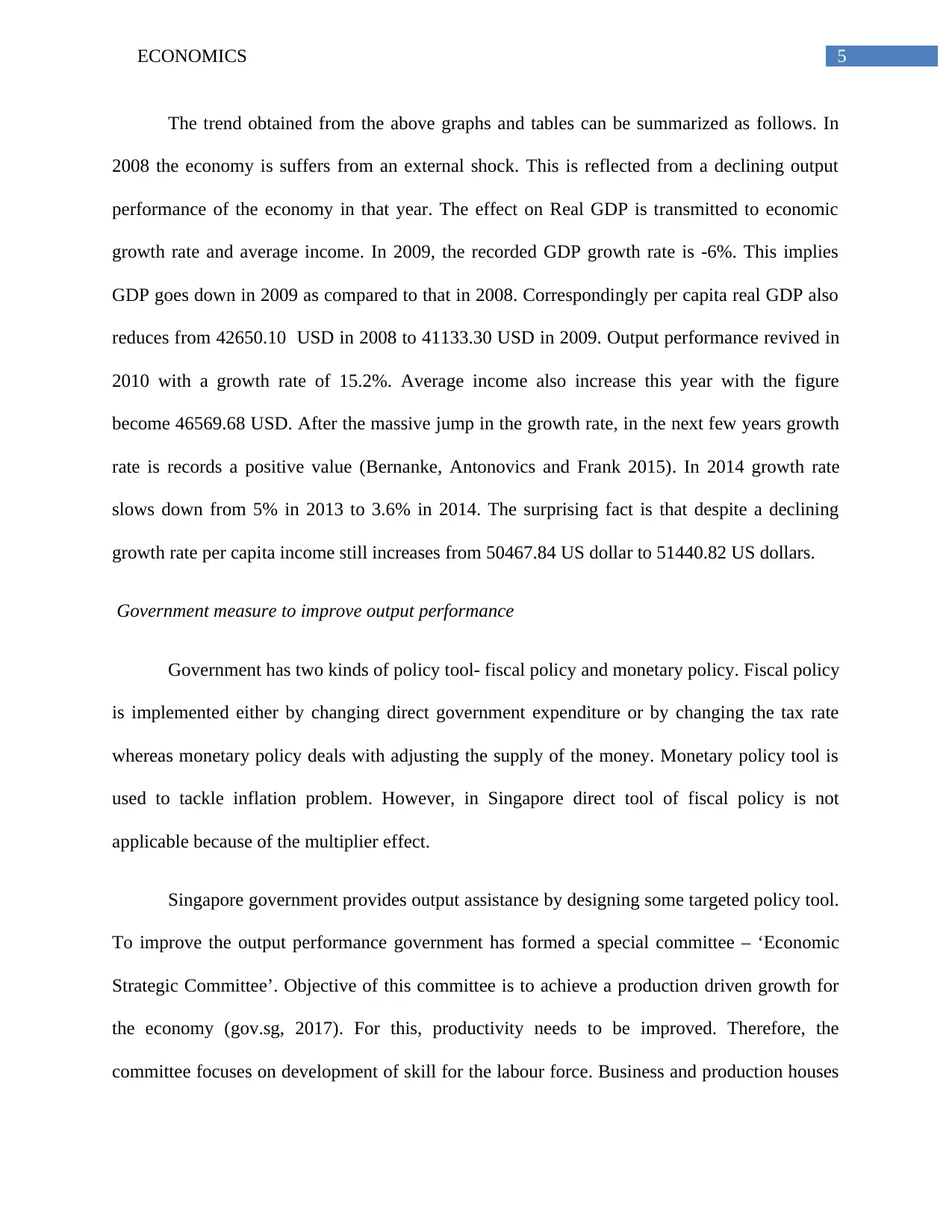
5ECONOMICS
The trend obtained from the above graphs and tables can be summarized as follows. In
2008 the economy is suffers from an external shock. This is reflected from a declining output
performance of the economy in that year. The effect on Real GDP is transmitted to economic
growth rate and average income. In 2009, the recorded GDP growth rate is -6%. This implies
GDP goes down in 2009 as compared to that in 2008. Correspondingly per capita real GDP also
reduces from 42650.10 USD in 2008 to 41133.30 USD in 2009. Output performance revived in
2010 with a growth rate of 15.2%. Average income also increase this year with the figure
become 46569.68 USD. After the massive jump in the growth rate, in the next few years growth
rate is records a positive value (Bernanke, Antonovics and Frank 2015). In 2014 growth rate
slows down from 5% in 2013 to 3.6% in 2014. The surprising fact is that despite a declining
growth rate per capita income still increases from 50467.84 US dollar to 51440.82 US dollars.
Government measure to improve output performance
Government has two kinds of policy tool- fiscal policy and monetary policy. Fiscal policy
is implemented either by changing direct government expenditure or by changing the tax rate
whereas monetary policy deals with adjusting the supply of the money. Monetary policy tool is
used to tackle inflation problem. However, in Singapore direct tool of fiscal policy is not
applicable because of the multiplier effect.
Singapore government provides output assistance by designing some targeted policy tool.
To improve the output performance government has formed a special committee – ‘Economic
Strategic Committee’. Objective of this committee is to achieve a production driven growth for
the economy (gov.sg, 2017). For this, productivity needs to be improved. Therefore, the
committee focuses on development of skill for the labour force. Business and production houses
The trend obtained from the above graphs and tables can be summarized as follows. In
2008 the economy is suffers from an external shock. This is reflected from a declining output
performance of the economy in that year. The effect on Real GDP is transmitted to economic
growth rate and average income. In 2009, the recorded GDP growth rate is -6%. This implies
GDP goes down in 2009 as compared to that in 2008. Correspondingly per capita real GDP also
reduces from 42650.10 USD in 2008 to 41133.30 USD in 2009. Output performance revived in
2010 with a growth rate of 15.2%. Average income also increase this year with the figure
become 46569.68 USD. After the massive jump in the growth rate, in the next few years growth
rate is records a positive value (Bernanke, Antonovics and Frank 2015). In 2014 growth rate
slows down from 5% in 2013 to 3.6% in 2014. The surprising fact is that despite a declining
growth rate per capita income still increases from 50467.84 US dollar to 51440.82 US dollars.
Government measure to improve output performance
Government has two kinds of policy tool- fiscal policy and monetary policy. Fiscal policy
is implemented either by changing direct government expenditure or by changing the tax rate
whereas monetary policy deals with adjusting the supply of the money. Monetary policy tool is
used to tackle inflation problem. However, in Singapore direct tool of fiscal policy is not
applicable because of the multiplier effect.
Singapore government provides output assistance by designing some targeted policy tool.
To improve the output performance government has formed a special committee – ‘Economic
Strategic Committee’. Objective of this committee is to achieve a production driven growth for
the economy (gov.sg, 2017). For this, productivity needs to be improved. Therefore, the
committee focuses on development of skill for the labour force. Business and production houses

6ECONOMICS
are encouraged for increasing investment in innovation and use advanced technology to increase
output.
There is a national council to look over efforts to increases productivity both from private
and public agencies (Hsueh, Hu & Tu, 2013). To enhance productivity research centres have
been set up in different parts of the nation.
Labour market analysis
Unemployment trend in Singapore
Unemployment figures in Singapore for the last ten years is given in the following table
Table 2: Rate of unemployment in Singapore
(Source: tradingeconomics.com 2017)
Year
Unemployment
Rate
2005 3.1
2006 3.1
2007 2.1
2008 2.2
2009 3
2010 2.1
2011 2
2012 1.9
2013 1.9
2014 1.95
are encouraged for increasing investment in innovation and use advanced technology to increase
output.
There is a national council to look over efforts to increases productivity both from private
and public agencies (Hsueh, Hu & Tu, 2013). To enhance productivity research centres have
been set up in different parts of the nation.
Labour market analysis
Unemployment trend in Singapore
Unemployment figures in Singapore for the last ten years is given in the following table
Table 2: Rate of unemployment in Singapore
(Source: tradingeconomics.com 2017)
Year
Unemployment
Rate
2005 3.1
2006 3.1
2007 2.1
2008 2.2
2009 3
2010 2.1
2011 2
2012 1.9
2013 1.9
2014 1.95
Paraphrase This Document
Need a fresh take? Get an instant paraphrase of this document with our AI Paraphraser
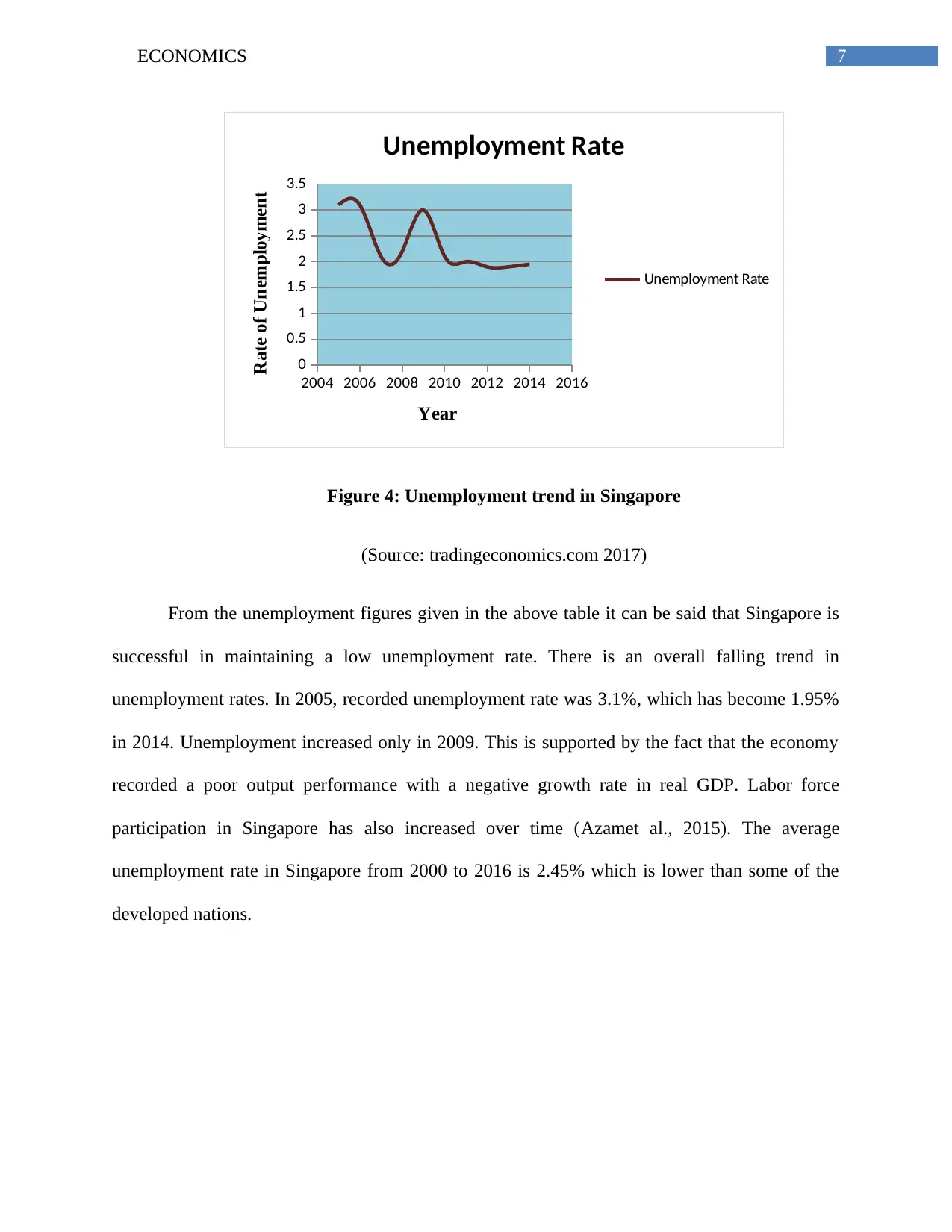
7ECONOMICS
2004 2006 2008 2010 2012 2014 2016
0
0.5
1
1.5
2
2.5
3
3.5
Unemployment Rate
Unemployment Rate
Year
Rate of Unemployment
Figure 4: Unemployment trend in Singapore
(Source: tradingeconomics.com 2017)
From the unemployment figures given in the above table it can be said that Singapore is
successful in maintaining a low unemployment rate. There is an overall falling trend in
unemployment rates. In 2005, recorded unemployment rate was 3.1%, which has become 1.95%
in 2014. Unemployment increased only in 2009. This is supported by the fact that the economy
recorded a poor output performance with a negative growth rate in real GDP. Labor force
participation in Singapore has also increased over time (Azamet al., 2015). The average
unemployment rate in Singapore from 2000 to 2016 is 2.45% which is lower than some of the
developed nations.
2004 2006 2008 2010 2012 2014 2016
0
0.5
1
1.5
2
2.5
3
3.5
Unemployment Rate
Unemployment Rate
Year
Rate of Unemployment
Figure 4: Unemployment trend in Singapore
(Source: tradingeconomics.com 2017)
From the unemployment figures given in the above table it can be said that Singapore is
successful in maintaining a low unemployment rate. There is an overall falling trend in
unemployment rates. In 2005, recorded unemployment rate was 3.1%, which has become 1.95%
in 2014. Unemployment increased only in 2009. This is supported by the fact that the economy
recorded a poor output performance with a negative growth rate in real GDP. Labor force
participation in Singapore has also increased over time (Azamet al., 2015). The average
unemployment rate in Singapore from 2000 to 2016 is 2.45% which is lower than some of the
developed nations.
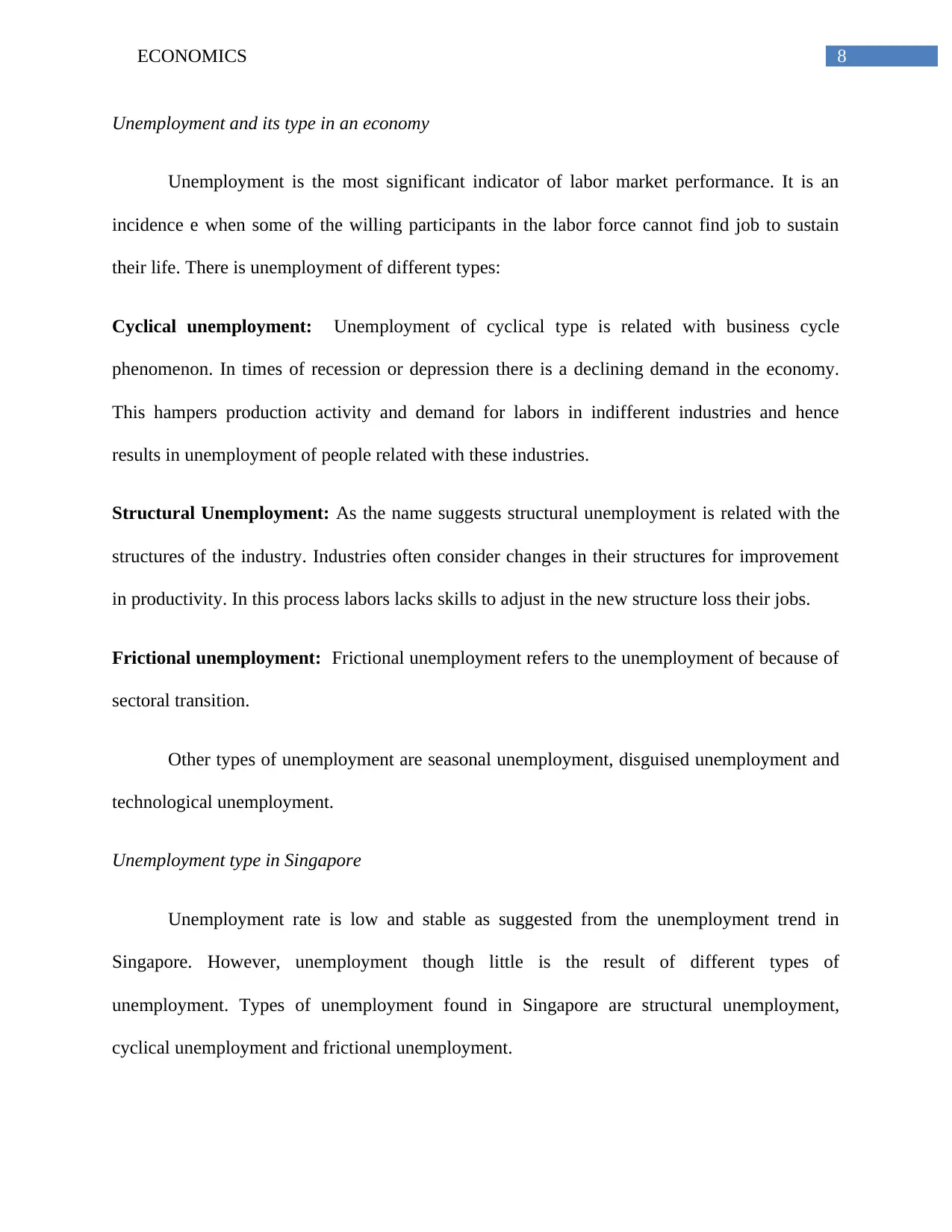
8ECONOMICS
Unemployment and its type in an economy
Unemployment is the most significant indicator of labor market performance. It is an
incidence e when some of the willing participants in the labor force cannot find job to sustain
their life. There is unemployment of different types:
Cyclical unemployment: Unemployment of cyclical type is related with business cycle
phenomenon. In times of recession or depression there is a declining demand in the economy.
This hampers production activity and demand for labors in indifferent industries and hence
results in unemployment of people related with these industries.
Structural Unemployment: As the name suggests structural unemployment is related with the
structures of the industry. Industries often consider changes in their structures for improvement
in productivity. In this process labors lacks skills to adjust in the new structure loss their jobs.
Frictional unemployment: Frictional unemployment refers to the unemployment of because of
sectoral transition.
Other types of unemployment are seasonal unemployment, disguised unemployment and
technological unemployment.
Unemployment type in Singapore
Unemployment rate is low and stable as suggested from the unemployment trend in
Singapore. However, unemployment though little is the result of different types of
unemployment. Types of unemployment found in Singapore are structural unemployment,
cyclical unemployment and frictional unemployment.
Unemployment and its type in an economy
Unemployment is the most significant indicator of labor market performance. It is an
incidence e when some of the willing participants in the labor force cannot find job to sustain
their life. There is unemployment of different types:
Cyclical unemployment: Unemployment of cyclical type is related with business cycle
phenomenon. In times of recession or depression there is a declining demand in the economy.
This hampers production activity and demand for labors in indifferent industries and hence
results in unemployment of people related with these industries.
Structural Unemployment: As the name suggests structural unemployment is related with the
structures of the industry. Industries often consider changes in their structures for improvement
in productivity. In this process labors lacks skills to adjust in the new structure loss their jobs.
Frictional unemployment: Frictional unemployment refers to the unemployment of because of
sectoral transition.
Other types of unemployment are seasonal unemployment, disguised unemployment and
technological unemployment.
Unemployment type in Singapore
Unemployment rate is low and stable as suggested from the unemployment trend in
Singapore. However, unemployment though little is the result of different types of
unemployment. Types of unemployment found in Singapore are structural unemployment,
cyclical unemployment and frictional unemployment.

9ECONOMICS
Structural unemployment: Singapore is an open economy. The economy increasing participate
in the globalization process with increasing global integration. However for successful
integration and become int6enationally competitive Singapore needs to consider revising
industrial and economic structure. This causes structural unemployment for some sectors. The
common incidence of structural unemployment is experience when some industries in Singapore
shifted to a labor saving production technology (Balassa, 2014).
Cyclical unemployment: Cyclical unemployment in Singapore causes due top fluctuation in
export demand. Many industries is Singapore is export depended. Therefore, unstable economic
condition of its trade partners affects aggregated demand in Sigapore4 and lead to cyclical
unemployment (Tan, 2015)
Frictional unemployment: With changing economic structure people in Singapore prefers vto
shift to some other industries and remain unemployed in between the switching period.
Singapore government measure for full unemployment
Singapore government targets for a full employment in Singapore and thus taken steps
for completely eliminating Unemployment.
One feature of Singapore labor force is that there are both domestic and foreign laborers.
It will be beneficial for the national labor market if vthe3se two groups of laborer work together
rather than competing with each other. Therefore, government encourages employers to hire
workers from both group and eliminate all discriminatory practices (Cheong et al., 2016).
Structural unemployment: Singapore is an open economy. The economy increasing participate
in the globalization process with increasing global integration. However for successful
integration and become int6enationally competitive Singapore needs to consider revising
industrial and economic structure. This causes structural unemployment for some sectors. The
common incidence of structural unemployment is experience when some industries in Singapore
shifted to a labor saving production technology (Balassa, 2014).
Cyclical unemployment: Cyclical unemployment in Singapore causes due top fluctuation in
export demand. Many industries is Singapore is export depended. Therefore, unstable economic
condition of its trade partners affects aggregated demand in Sigapore4 and lead to cyclical
unemployment (Tan, 2015)
Frictional unemployment: With changing economic structure people in Singapore prefers vto
shift to some other industries and remain unemployed in between the switching period.
Singapore government measure for full unemployment
Singapore government targets for a full employment in Singapore and thus taken steps
for completely eliminating Unemployment.
One feature of Singapore labor force is that there are both domestic and foreign laborers.
It will be beneficial for the national labor market if vthe3se two groups of laborer work together
rather than competing with each other. Therefore, government encourages employers to hire
workers from both group and eliminate all discriminatory practices (Cheong et al., 2016).
Secure Best Marks with AI Grader
Need help grading? Try our AI Grader for instant feedback on your assignments.
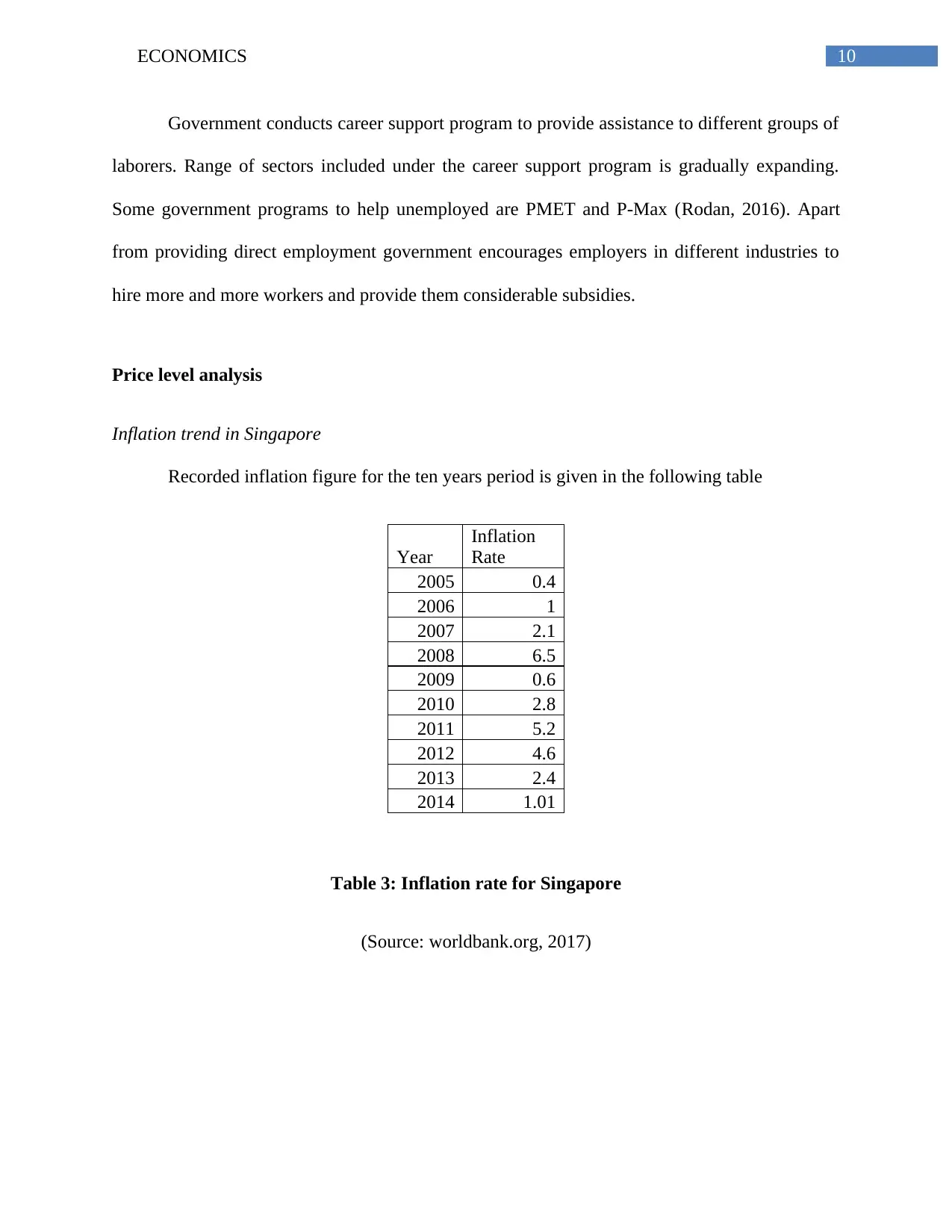
10ECONOMICS
Government conducts career support program to provide assistance to different groups of
laborers. Range of sectors included under the career support program is gradually expanding.
Some government programs to help unemployed are PMET and P-Max (Rodan, 2016). Apart
from providing direct employment government encourages employers in different industries to
hire more and more workers and provide them considerable subsidies.
Price level analysis
Inflation trend in Singapore
Recorded inflation figure for the ten years period is given in the following table
Year
Inflation
Rate
2005 0.4
2006 1
2007 2.1
2008 6.5
2009 0.6
2010 2.8
2011 5.2
2012 4.6
2013 2.4
2014 1.01
Table 3: Inflation rate for Singapore
(Source: worldbank.org, 2017)
Government conducts career support program to provide assistance to different groups of
laborers. Range of sectors included under the career support program is gradually expanding.
Some government programs to help unemployed are PMET and P-Max (Rodan, 2016). Apart
from providing direct employment government encourages employers in different industries to
hire more and more workers and provide them considerable subsidies.
Price level analysis
Inflation trend in Singapore
Recorded inflation figure for the ten years period is given in the following table
Year
Inflation
Rate
2005 0.4
2006 1
2007 2.1
2008 6.5
2009 0.6
2010 2.8
2011 5.2
2012 4.6
2013 2.4
2014 1.01
Table 3: Inflation rate for Singapore
(Source: worldbank.org, 2017)

11ECONOMICS
2004 2006 2008 2010 2012 2014 2016
0
1
2
3
4
5
6
7
Inflation Rate
Inflation Rate
Year
Rate of inflation
Figure 5: Inflation trend in Singapore
(Source: worldbank.org, 2017)
Like unemployment rate inflation in price level in Singapore is in a stable state. The
country makes significant improvement in its inflation trend since 1960. Consumer Price Index is
used in Singapore for measuring core inflation rate. Cost of food and transportation has increased
while that of housing cost declined (Samarina & De Haan, 2014). There are some variations in
monthly inflation rate and may record slight increase from one month to another. However, the
overall inflation rate is falling and stable.
Inflation and its causes in an economy
Fluctuation in the price level is measured with the inflation and deflation in the economy.
Inflation is defined as a steady rise in the price level (Stiglitz, 2015). Inflation in an economy
occurs wither due to demand side factor or due to cost side factors. Accordingly inflation is
termed as demand pull inflation and cost push inflation.
2004 2006 2008 2010 2012 2014 2016
0
1
2
3
4
5
6
7
Inflation Rate
Inflation Rate
Year
Rate of inflation
Figure 5: Inflation trend in Singapore
(Source: worldbank.org, 2017)
Like unemployment rate inflation in price level in Singapore is in a stable state. The
country makes significant improvement in its inflation trend since 1960. Consumer Price Index is
used in Singapore for measuring core inflation rate. Cost of food and transportation has increased
while that of housing cost declined (Samarina & De Haan, 2014). There are some variations in
monthly inflation rate and may record slight increase from one month to another. However, the
overall inflation rate is falling and stable.
Inflation and its causes in an economy
Fluctuation in the price level is measured with the inflation and deflation in the economy.
Inflation is defined as a steady rise in the price level (Stiglitz, 2015). Inflation in an economy
occurs wither due to demand side factor or due to cost side factors. Accordingly inflation is
termed as demand pull inflation and cost push inflation.
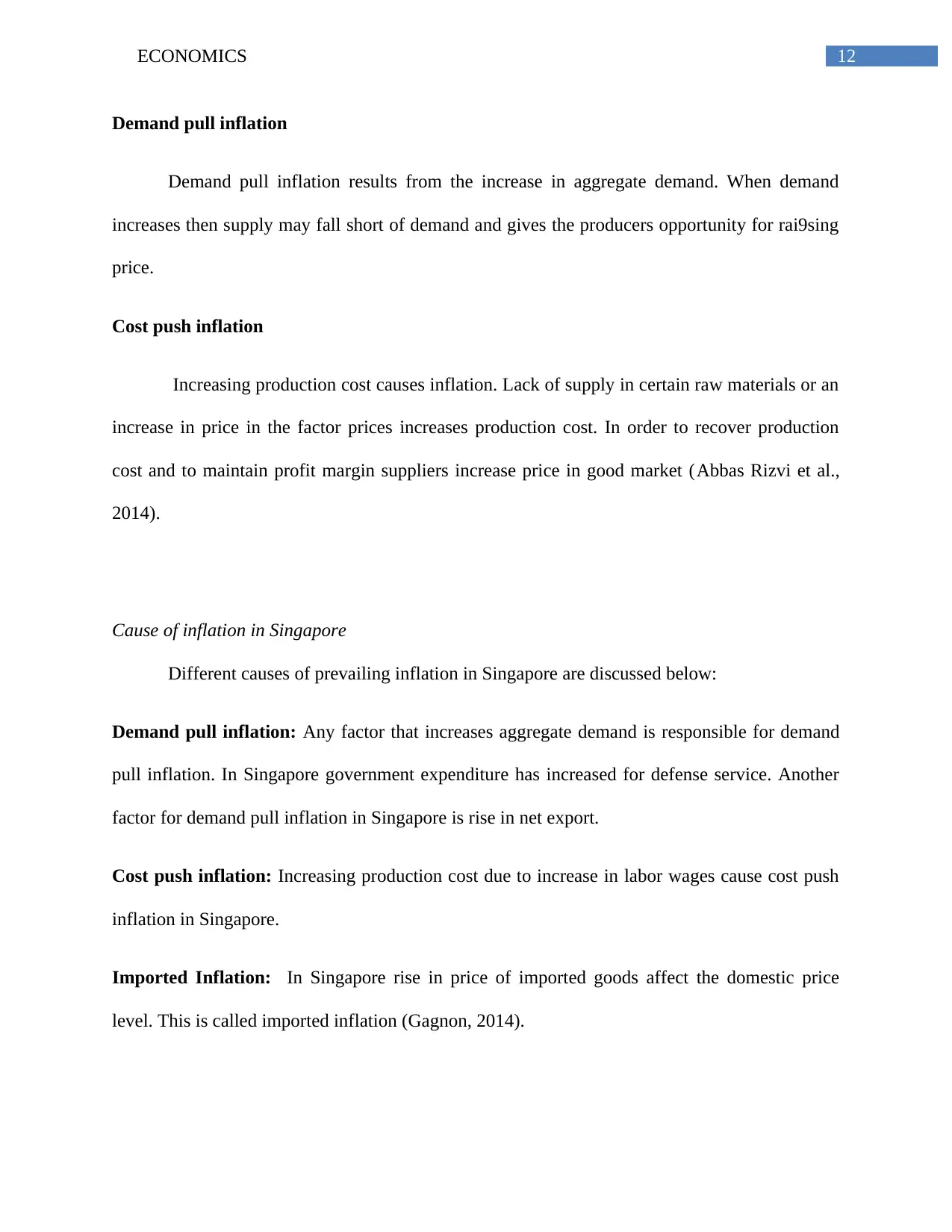
12ECONOMICS
Demand pull inflation
Demand pull inflation results from the increase in aggregate demand. When demand
increases then supply may fall short of demand and gives the producers opportunity for rai9sing
price.
Cost push inflation
Increasing production cost causes inflation. Lack of supply in certain raw materials or an
increase in price in the factor prices increases production cost. In order to recover production
cost and to maintain profit margin suppliers increase price in good market (Abbas Rizvi et al.,
2014).
Cause of inflation in Singapore
Different causes of prevailing inflation in Singapore are discussed below:
Demand pull inflation: Any factor that increases aggregate demand is responsible for demand
pull inflation. In Singapore government expenditure has increased for defense service. Another
factor for demand pull inflation in Singapore is rise in net export.
Cost push inflation: Increasing production cost due to increase in labor wages cause cost push
inflation in Singapore.
Imported Inflation: In Singapore rise in price of imported goods affect the domestic price
level. This is called imported inflation (Gagnon, 2014).
Demand pull inflation
Demand pull inflation results from the increase in aggregate demand. When demand
increases then supply may fall short of demand and gives the producers opportunity for rai9sing
price.
Cost push inflation
Increasing production cost causes inflation. Lack of supply in certain raw materials or an
increase in price in the factor prices increases production cost. In order to recover production
cost and to maintain profit margin suppliers increase price in good market (Abbas Rizvi et al.,
2014).
Cause of inflation in Singapore
Different causes of prevailing inflation in Singapore are discussed below:
Demand pull inflation: Any factor that increases aggregate demand is responsible for demand
pull inflation. In Singapore government expenditure has increased for defense service. Another
factor for demand pull inflation in Singapore is rise in net export.
Cost push inflation: Increasing production cost due to increase in labor wages cause cost push
inflation in Singapore.
Imported Inflation: In Singapore rise in price of imported goods affect the domestic price
level. This is called imported inflation (Gagnon, 2014).
Paraphrase This Document
Need a fresh take? Get an instant paraphrase of this document with our AI Paraphraser
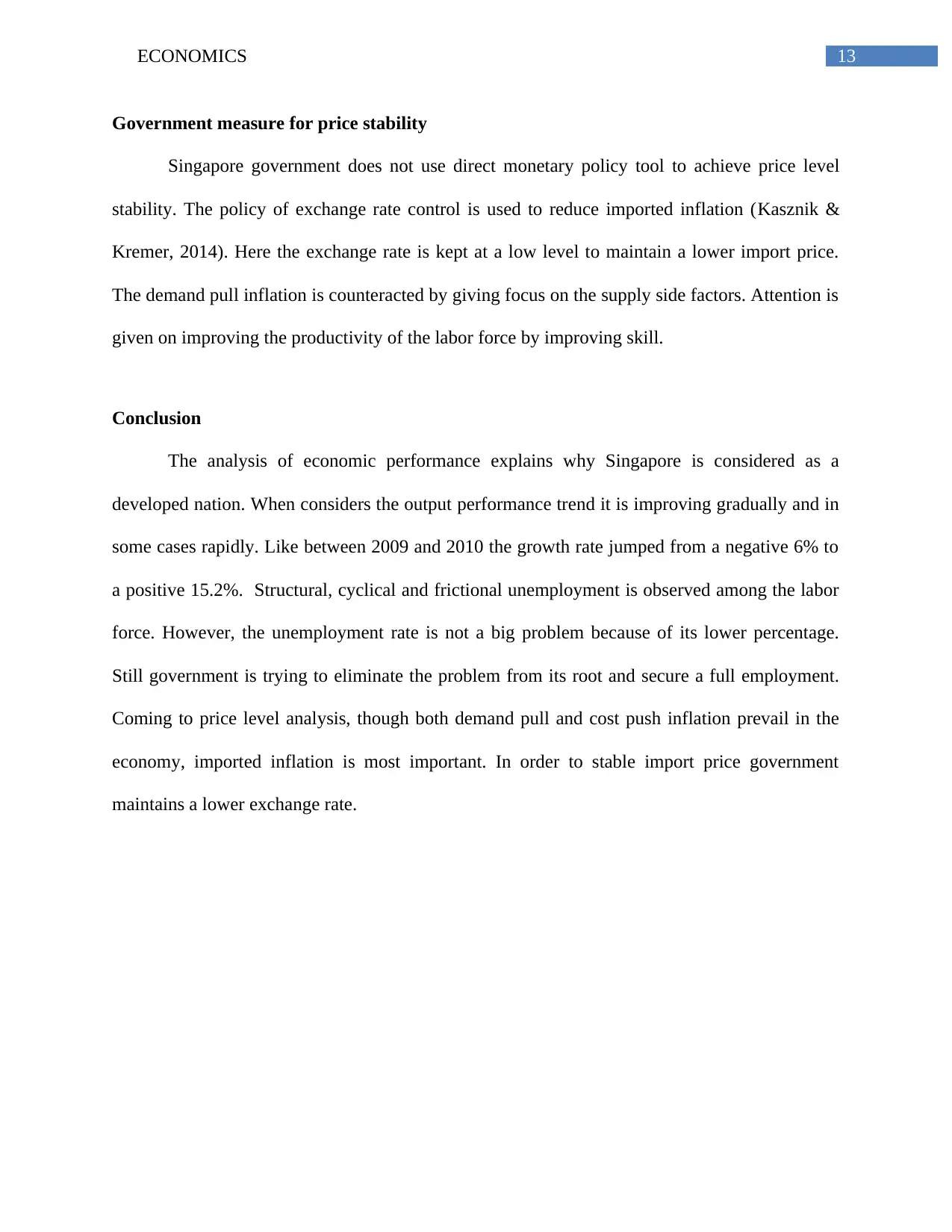
13ECONOMICS
Government measure for price stability
Singapore government does not use direct monetary policy tool to achieve price level
stability. The policy of exchange rate control is used to reduce imported inflation (Kasznik &
Kremer, 2014). Here the exchange rate is kept at a low level to maintain a lower import price.
The demand pull inflation is counteracted by giving focus on the supply side factors. Attention is
given on improving the productivity of the labor force by improving skill.
Conclusion
The analysis of economic performance explains why Singapore is considered as a
developed nation. When considers the output performance trend it is improving gradually and in
some cases rapidly. Like between 2009 and 2010 the growth rate jumped from a negative 6% to
a positive 15.2%. Structural, cyclical and frictional unemployment is observed among the labor
force. However, the unemployment rate is not a big problem because of its lower percentage.
Still government is trying to eliminate the problem from its root and secure a full employment.
Coming to price level analysis, though both demand pull and cost push inflation prevail in the
economy, imported inflation is most important. In order to stable import price government
maintains a lower exchange rate.
Government measure for price stability
Singapore government does not use direct monetary policy tool to achieve price level
stability. The policy of exchange rate control is used to reduce imported inflation (Kasznik &
Kremer, 2014). Here the exchange rate is kept at a low level to maintain a lower import price.
The demand pull inflation is counteracted by giving focus on the supply side factors. Attention is
given on improving the productivity of the labor force by improving skill.
Conclusion
The analysis of economic performance explains why Singapore is considered as a
developed nation. When considers the output performance trend it is improving gradually and in
some cases rapidly. Like between 2009 and 2010 the growth rate jumped from a negative 6% to
a positive 15.2%. Structural, cyclical and frictional unemployment is observed among the labor
force. However, the unemployment rate is not a big problem because of its lower percentage.
Still government is trying to eliminate the problem from its root and secure a full employment.
Coming to price level analysis, though both demand pull and cost push inflation prevail in the
economy, imported inflation is most important. In order to stable import price government
maintains a lower exchange rate.

14ECONOMICS
References
Abbas Rizvi, S. K., Naqvi, B., Bordes, C., & Mirza, N. (2014). Inflation volatility: an Asian
perspective. Ekonomska istraživanja, 27(1), 280-303.
Azam, M., Khan, A. Q., Bakhtyar, B., & Emirullah, C. (2015). The causal relationship between
energy consumption and economic growth in the ASEAN-5 countries. Renewable and
Sustainable Energy Reviews, 47, 732-745.
Balassa, B. (2014). Development Strategies'. International Economics and Development: Essays
in Honor of Raúl Prebisch, 159.
Bernanke, B., Antonovics, K. and Frank, R., 2015. Principles of macroeconomics. McGraw-Hill
Higher Education.
Cheong, K. C., Hill, C., Fernandez-Chung, R., & Leong, Y. C. (2016). Employing the
‘unemployable’: employer perceptions of Malaysian graduates. Studies in Higher
Education, 41(12), 2253-2270.
Data.worldbank.org. Retrieved 2 August 2017, from
http://data.worldbank.org/country/singapore.
Gagnon, J. E. (2014). Alternatives to Currency Manipulation: What Switzerland, Singapore, and
Hong Kong Can Do. change, 2012, 13.
gov.sg | How is the government helping to mitigate inflation in Singapore?. (2017). Gov.sg.
Retrieved 3 July 2017, from https://www.gov.sg/factually/content/how-is-the-
government-helping-to-mitigate-inflation-in-singapore
References
Abbas Rizvi, S. K., Naqvi, B., Bordes, C., & Mirza, N. (2014). Inflation volatility: an Asian
perspective. Ekonomska istraživanja, 27(1), 280-303.
Azam, M., Khan, A. Q., Bakhtyar, B., & Emirullah, C. (2015). The causal relationship between
energy consumption and economic growth in the ASEAN-5 countries. Renewable and
Sustainable Energy Reviews, 47, 732-745.
Balassa, B. (2014). Development Strategies'. International Economics and Development: Essays
in Honor of Raúl Prebisch, 159.
Bernanke, B., Antonovics, K. and Frank, R., 2015. Principles of macroeconomics. McGraw-Hill
Higher Education.
Cheong, K. C., Hill, C., Fernandez-Chung, R., & Leong, Y. C. (2016). Employing the
‘unemployable’: employer perceptions of Malaysian graduates. Studies in Higher
Education, 41(12), 2253-2270.
Data.worldbank.org. Retrieved 2 August 2017, from
http://data.worldbank.org/country/singapore.
Gagnon, J. E. (2014). Alternatives to Currency Manipulation: What Switzerland, Singapore, and
Hong Kong Can Do. change, 2012, 13.
gov.sg | How is the government helping to mitigate inflation in Singapore?. (2017). Gov.sg.
Retrieved 3 July 2017, from https://www.gov.sg/factually/content/how-is-the-
government-helping-to-mitigate-inflation-in-singapore

15ECONOMICS
Hsueh, S. J., Hu, Y. H., & Tu, C. H. (2013). Economic growth and financial development in
Asian countries: a bootstrap panel Granger causality analysis. Economic Modelling, 32,
294-301.
Kasznik, R., & Kremer, I. (2014). The Strategic Timing of Management Earnings Forecasts
around Scheduled Releases of Macroeconomic News(No. 3046).
Rodan, G. (2016). The political economy of Singapore's industrialization: national state and
international capital. Springer.
Samarina, A., & De Haan, J. (2014). Right on target: exploring the factors leading to inflation
targeting adoption. Contemporary Economic Policy, 32(2), 372-389.
Smith, C. J., Donaldson, J. A., Mudaliar, S., Md Kadir, M., & Yeoh, L. K. (2015). A handbook
on inequality, poverty and unmet social needs in Singapore.
Stiglitz, J. E. (2015). Reconstructing macroeconomic theory to manage economic policy.
In Fruitful Economics (pp. 20-56). Palgrave Macmillan UK.
Tan, A. H. (2015). Economic prospects of Singapore.
Tradingeconomics.com. Retrieved 2 August 2017, from
https://tradingeconomics.com/singapore/labor-force-participation-rate
Hsueh, S. J., Hu, Y. H., & Tu, C. H. (2013). Economic growth and financial development in
Asian countries: a bootstrap panel Granger causality analysis. Economic Modelling, 32,
294-301.
Kasznik, R., & Kremer, I. (2014). The Strategic Timing of Management Earnings Forecasts
around Scheduled Releases of Macroeconomic News(No. 3046).
Rodan, G. (2016). The political economy of Singapore's industrialization: national state and
international capital. Springer.
Samarina, A., & De Haan, J. (2014). Right on target: exploring the factors leading to inflation
targeting adoption. Contemporary Economic Policy, 32(2), 372-389.
Smith, C. J., Donaldson, J. A., Mudaliar, S., Md Kadir, M., & Yeoh, L. K. (2015). A handbook
on inequality, poverty and unmet social needs in Singapore.
Stiglitz, J. E. (2015). Reconstructing macroeconomic theory to manage economic policy.
In Fruitful Economics (pp. 20-56). Palgrave Macmillan UK.
Tan, A. H. (2015). Economic prospects of Singapore.
Tradingeconomics.com. Retrieved 2 August 2017, from
https://tradingeconomics.com/singapore/labor-force-participation-rate
1 out of 16
Related Documents
Your All-in-One AI-Powered Toolkit for Academic Success.
+13062052269
info@desklib.com
Available 24*7 on WhatsApp / Email
![[object Object]](/_next/static/media/star-bottom.7253800d.svg)
Unlock your academic potential
© 2024 | Zucol Services PVT LTD | All rights reserved.




